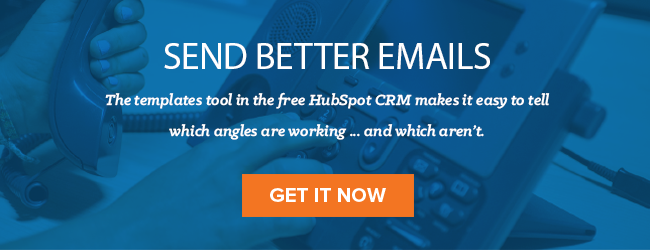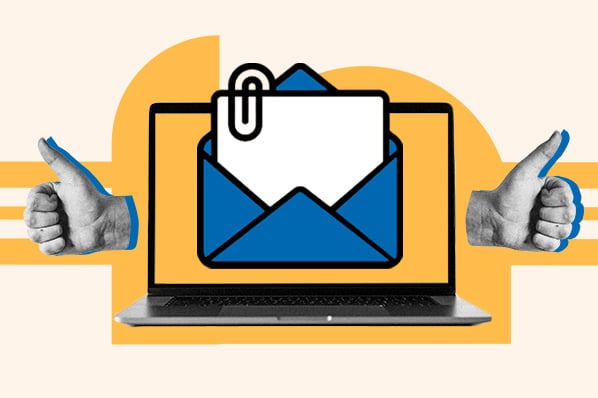 To be effective, sales follow-up emails must change. Dramatically.
To be effective, sales follow-up emails must change. Dramatically.
Generic messages that reference “just following up” or “just checking in” no longer work. For example:
Hey [enter customer name],
Thought I'd check in and say hello. How's everything going? I know it's been a little bit since we last spoke, so I'm just following up. Thanks.
- Annoying Sales Rep Allen
A prospect has no reason to respond to this email.
And while it includes their first name, it’s a generic message. It lacks the core components necessary to move this prospect into the next phase of the sales process.
By including a few critically important features, reps can finally stop sending pointless and obnoxious emails, and start sending ones that actually get responses and result in customers. The traditional method of high-volume generic emails doesn't work. It’s time to be human with our prospects.
Here are three things to keep in mind each and every time you write a checking-in email.
1) Include a call-to-action.
It’s your job to move the buyer you’re emailing into the next phase of the funnel, which is why including a call-to-action is critical. Whether it’s in your subject line or the final remarks at the end of the email, discussing what’s next in the process is necessary for success.
In fact, including a CTA can boost a prospect’s curiosity, making it more likely that they follow up with you. The Drive Theory of Curiosity holds that when we have a general idea of what’s supposed to happen next, we’re more motivated to check it out and see what actually happens.
Here are some easy CTAs to include in your follow-up sales emails:
- Ask about a time that’s best for them to hop on the phone and discuss your idea further.
- Offer a product demonstration in order to spark their interest.
- Ask for their thoughts about how the two of you can deepen your relationship. While it’s great to hop on the phone, it’s better to hear directly from the prospect what they want to do to take this to the next phase.
2) Personalize.
It’s great to include a prospect’s first name in an email, but you should strive to get a little more personal than that. Sales reps and buyers now have access to tons of information about one another. A sales rep knows where their prospect works, how long they’ve been there, where they’re from, and more.
With this knowledge, sales reps can -- and should -- personalize each of their sales emails. After all, sales is ultimately about personal relationships.
Include phrases such as:
- Hope all is well in [hometown] and you aren’t getting hit with too much X weather!
- By the way, I read your blog post on [enter subject], and I’d love to chat more about your ideas.
- Can you believe [college] lost by that many points this weekend? Wow!
3) Add a piece of content.
Content continues to shape how customers make their buying decisions. People value trustworthy content, and they want to read what others are saying about a product or a service.
Using content in sales isn’t a new idea, but it’s still not widely adopted. Sending a story about a company or person in a similar position as the prospect that describes how your product or service helped solve their problems is huge for sparking interest.
Consider sending one or more of the following types of content:
1) A case study or testimonial.
Customers love hearing from other customers. Here’s your chance to boast about your product or service -- without actually doing it. Humans love stories and they value their peers’ opinions.
2) A blog post from you.
Building credibility is also critical if you want to be successful in sales. Taking to the internet and producing some content around the industry you sell into is a great way to do this. After you write something, be sure to send it out to your prospects. Not only will this build your credibility, it also gives you a reason to reach out and share something with your client, which will keep the conversation going.
3) Content around your company.
Again, buyers love to read about products before they talk to salespeople, especially in the form of media articles or blog posts. They are doing as much research as they can before making a decision, so why not help in that research by providing some content?
There’s no point in sending an unnecessary “just following up” email to a prospect anymore. The playbook has changed. Nowadays, the goal is to be in tune with your prospect, research and get to know them, and develop an email strategy around what you’ve learned.
Ideally, you begin sales engagements with the knowledge that buyers are interested in your service. As a sales rep, it’s your job to build relationships based on this initial interest, and maintain them. With this these three tips, you can craft compelling emails that will help you do just that.







![How to Introduce Yourself in an Email in [Almost] Every Situation](https://www.hubspot.com/hubfs/how-to-introduce-yourself-over-email-1.jpg)


![23 Sales Email Templates With 60% or Higher Open Rates [+ Bonus Templates]](https://www.hubspot.com/hubfs/sales-email-templates-2.jpg)


